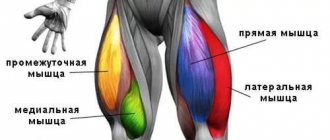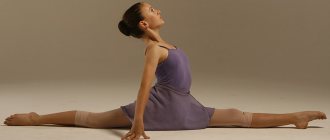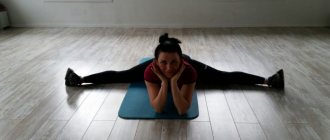One of the most striking ways to demonstrate flexibility is the cross split. Every girl at least once wanted to surprise others and, first of all, herself with stretching and make an impression. Twine is used in many types of physical activity - in dancing, martial arts, and for rhythmic gymnasts, longitudinal and transverse twine is a mandatory element of the program.
In order to do the cross splits, you will need to put in a lot of effort. But how beautiful!
The difficulty is that the cross split is considered the most difficult type of stretching and for many it remains a dream due to insufficient perseverance or body type. Practice shows that making a dream come true is not so difficult, because the main thing is to have the desire and strive to achieve the goal. Are you ready to make your dreams come true? Let's find out how to do the cross splits.
How do the splits
Today I will reveal to you a person whose book helped me increase flexibility and mobility in my joints. I consider him one of the most knowledgeable teachers in stretching.
He is one of the pioneers of tricking, I learned about him from videos on YouTube:
And then I found and read him trickstutorials.com Now he has a new website, but he started writing his book on stretching there. He took most of the ideas from other authors and tested them on himself.
His name is John Call, but most people know him as Jujimufu
Over time, John increasingly moved away from tricking into bodybuilding. But I didn’t lose my stretch. Now his YouTube has changed. He matured, grew a beard and a mountain of muscles. He still jumps well, and his stretch is enviable:
His book and ideas helped me put together my stretching system. At that time, he posted chapters of the book for free on his website.
You can find the latest version of stretching in English here: legendaryflexibility.com for $25
Why do the splits
If you are reading these lines, most likely you know why you need twine. But even if not, I will give you several reasons to read to the end of the article and incorporate stretching exercises into your training regimen.
The benefits of stretching are:
- Mobility in the joints and absence of pain when moving.
- Treatment and prevention of age-related diseases and diseases associated with circulatory disorders.
- For older men, split exercises are especially useful, as they improve blood supply to the pelvic joints.
- For martial artists, it is much easier to perform high-level kicks and technical techniques in wrestling.
- Splits are not a goal, but a means to improve the overall well-being and flexibility of the whole body.
Basic principles of flexibility
Flexibility is the ability to control the amplitude and direction of movements in the joints. Every person has limitations. To combat restrictions, special exercises are used that increase the length of muscles and ligaments.
Jujimufu proposed to classify flexibility according to the type of muscle activity and the use of external forces to increase amplitude. Of greatest interest to us are:
- Dynamic active flexibility
- Static active flexibility
- Static passive flexibility
Dynamic active includes swinging arms and legs with full amplitude, while the stretched muscles are relaxed, and the movement occurs due to the tension of the antagonists.
Static active allows you to maintain the adopted position only by the strength of the muscles of the protogonists. As an example, holding a high leg in taekwondo athletes. This is isometric.
Static passive involves taking and maintaining static positions with the help of a partner, your own weight, the weight of a barbell, or the use of elastic bands.
Flexibility Factors
There are a lot of such factors. Your flexibility is affected by:
- Shape and structure of the joint. Ligaments and tendons also affect flexibility
- Women are naturally more flexible, if you're a man you're out of luck
- Flexibility decreases with age. This deterioration can be reversed with regular exercise.
- Emotional state affects flexibility. The next time you have wings of joy, immediately fly into the splits. While negative thoughts and fatigue impair flexibility and coordination
- Times of Day. You've probably noticed that it's harder to stretch in the morning.
- Preliminary exercises and warming up the muscles. Before doing the splits, you need to do a few preparatory exercises.
- If you do dynamic exercises when you are tired, your amplitude can greatly decrease. Therefore, the order of the exercises is important.
- Each exercise has its own technique. Incorrect technique interferes with stretching progress.
- Sudden uncontrolled movements pose a health hazard. Watch for smoothness and amplitude
- Isometric stretching is better than static stretching and gives faster results. But more dangerous to use
- Insufficiently strong muscles also slow down your stretching. The stronger you are, the better
- Restricted joint movement can reduce your stretch. For example, long training sessions on roller skates or ice skating. So don't forget to stretch these muscle groups after these workouts.
- Body and ambient temperature affect your flexibility
Types of twines
The most common varieties of this exercise are longitudinal and transverse splits.
- When longitudinal, the legs are extended in one line: one forward, the other backward.
- With the transverse, the legs are spread apart, the pelvis is on the floor surface.
These splits are considered “simple.” Other types are available only to professionals. Among them we can mention the vertical one, which is performed while standing and can be both longitudinal and transverse, and the split on the arms (can also be both transverse and longitudinal).
How long will it take to do the splits?
Numerous articles posted online do not provide a clear answer to this question. This is not surprising: the speed of mastering the splits is determined by natural abilities, health, physical fitness, age, anatomical features and many other purely individual factors. It is known that young athletes can do the splits easier and faster. But the point here is not only in the mobility of joints and the elasticity of young muscles, but also in the fact that in gymnastics sections they usually do not stand on ceremony with students. Adults who exercise independently treat their bodies more humanely. As a result, progress is slower. Nevertheless, even in adulthood a person can master longitudinal or transverse splits.
Another thing is that for some it will take several weeks, while for others it will take several years.
Precautionary measures
Whatever types of splits you learn, the key exercise should be preceded by a warm-up. It can be any type of physical activity: jogging (including on the spot), cycling or exercise equipment, strength training or a set of cardio exercises.
The purpose of warming up is to warm up the muscle fibers. This measure prevents micro-tears in the muscles and prepares the joints for stress. In addition, warmed muscles relax faster and easier, and this is important, since only a relaxed muscle can be stretched (and even then not immediately). If you are short on time, you can use a few simple stretching exercises as a warm-up. You also need to remember that stretching should not be rushed. Don’t even ask how long it takes your friends to do the splits, otherwise you will always compare yourself with someone else.
Listen only to your body! All movements must be performed carefully and slowly; You need to be in the same position for at least 30 (or better – 60) seconds. Most likely, you will experience pain, but it should be moderate. Sharp pain indicates an injury has occurred. It is incompatible with training.
Split stretch for beginners (universal muscle stretching exercises)
It is also important to note that the training should be long enough – at least an hour. But the most important thing is regularity. You can achieve success only through daily training. You should start with simple exercises performed in several approaches: straight leg swings, squats with legs apart, bends forward with straight legs. The more muscles involved in the workout, the better.
Exercises that are performed while lying on your back are also recommended: lifting the leg at a right angle, bending the leg at the knee and pulling it to the chest.
The classic exercises are very useful: “paperclip” and “butterfly”. In the first case, you need to kneel, spread your heels and lean back (ideally, lie on the floor). In the second case, you need to sit on the floor, bring your feet together and spread your knees, and then try to press your knees to the floor. Split stretching for beginners should consist of relatively simple exercises that do not cause discomfort. The easier they are for you, the closer you are to your final goal.
How to do the splits quickly, the first secret of Jujimufu
Enough theory, although it has already given you food for preparation. Let's move on to the exercises. If the goal is a split for the sake of a split. Then the program will be convincingly simple.
The main warm-up is needed to warm up the joints and improve blood supply to the muscles.
Rotational movements in the joints, bending and small swings. Light jogging, jump rope, squats, push-ups, horizontal bar.
Main part
Dynamic and static active stretching. Swing your legs to maximum amplitude 20–50 times in different directions. Hold your legs in the air in a static position for 45 – 60 seconds.
Isometrics in split positions.
Final part
Statically passive stretches. Perhaps yoga.
The entire workout can take you from 10 to 120 minutes. Depending on preparation and number of exercises. If we are talking only about cross twine. Then 10 – 20 minutes is enough.
Isometrics can be performed 2 – 3 times a week. Static passive and active stretches several times a day. Moreover, the first ones every day, let’s say in the morning and evening.
I would suggest adding exercises to all muscle groups, not just the legs. And a separate strength training session. The best in my opinion is martial arts. And of course, working with free weights to develop strength. Kettlebells, barbell, etc.
What is isometry in simple words
The founder of isometrics is considered to be the Russian circus wrestler Alexander Zas. His training was about overcoming the insurmountable. Breaking thick chains, twisting scrap iron, nails, etc.
He developed a whole system of strength exercises with chains. And this is exactly how most people associate isometrics. As a system for developing strength.
Let's talk about isometrics in terms of the cross split stretch. In this case, isometric stretching will look like this:
Adopting the lowest possible position of the pelvis, legs to the sides. Position of the cross twine. The pelvis is in line with the legs and body. You can hold onto the chair with your hands.
We strain the leg muscles as much as possible, as if we were trying to stand on straight legs and connect them together for 4 - 5 seconds. Then we relax the muscles and sit down to relax a little lower.
And so on until you achieve maximum stretching. At the lowest point, hold the tension for 30 seconds. Then take a break and repeat a few more times.
We do the same in longitudinal twine.
Isometric stretching is one of the most effective and fastest ways to do the splits. But at the same time quite dangerous. Because it can lead to injury. In any case, I do not recommend doing isometrics more than 3 times a week.
This is the first and most important secret of Jujimufu
Features of cross twine
Mastering the longitudinal split does not mean performing the transverse split.
Here, stretching of all the adductor muscles of the thigh occurs: short, long, large, as well as the inner and outer sides of the back of the thigh, thin and pectineus muscles.
Performing such a split involves positioning the legs transversely, that is, the legs are in the same horizontal position - apart from the body.
Entering the splits is performed by bending the torso forward with emphasis on the hands, then sliding the legs apart until they reach a horizontal position, touching the floor with the pelvis.
Sagging of this type of twine is often used in sports. One leg is also on a hill, and the pelvis tends to the floor.
Read more about cross twine →
The second secret, the necessary things for the twine
For twine you need:
- Some free space, preferably in nature, but you can also at home, the main thing is that the TV and mezzanine do not fall into the zone of your swinging legs. It's not just bad for TV.
- Some kind of decking, platforms or fences. To put your foot on them. The better your stretch, the higher your support should be. Everything can be found in the yard. For example, an outdoor wall bars or a tree with low-growing branches.
- Wall. This is a great place to stretch.
- An ordinary chair or armchair. They will help you control your position in the splits. You can lean on your hands or put your foot down if there is no splits at all. You can also stretch on chairs like Van Dame
- Stick, branch, towel or rubber. They will help pull the shoulder joints and back, and the rubber will also create additional pressure.
Features of longitudinal twine
By the name you can already determine in which direction the traction will be carried out. In this case - longitudinal extension, that is, one leg is in front of the body, and the other is behind.
Performing the splits begins with one of the legs lunging forward, after which the angle between the thighs is reduced, allowing for sliding. To perform the exercise safely, you should rest your hands on the floor to control the intensity and speed of muscle stretching.
Correct execution of the longitudinal split is a position in which the legs take a strictly horizontal position, touching the floor with the pelvis. The torso should be directed straight forward, the front leg should lie on the back of the thighs, and the back leg on the front. It is important not to twist your pelvis.
In professional sports, the sagging method is used, in which the split is performed with one leg on a hill, while the pelvis should also touch the floor.
When performing longitudinal twine, the following are stretched:
- Adductor longus muscle.
- Thin muscle.
- Gluteus maximus muscle.
- Muscles of the back of the thigh.
- Calf muscle.
- Sartorius.
- Rectus femoris muscle.
- Pectineus muscle.
- Tensor fascia lata.
Read more about longitudinal twine →
Secret four, how to do the splits at home
Firstly, take care of furniture and dishes. Your kicking is bad for your mother's dinnerware. Provide yourself with free space. It would also be nice to allocate a place near the wall so that your legs and arms do not rest on chairs and sofas.
Use a table, chair and books for your exercises, but do not break them. Be more careful. It is better to use a soft mat and pillows to prevent knee pain.
When climbing onto two chairs, remember that they may fall. And with them you and the barbell. Pay attention to this. And they can simply fall apart.











